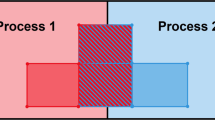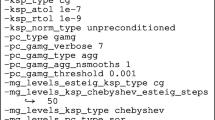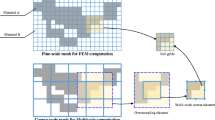Abstract
Topology optimization is often used in the conceptual design stage as a preprocessing tool to obtain overall material distribution in the solution domain. The resulting topology is then used as an initial guess for shape optimization. It is always desirable to use fine computational grids to obtain high-resolution layouts that minimize the need for shape optimization and postprocessing (Bendsoe and Sigmund, Topology optimization theory, methods and applications. Springer, Berlin Heidelberg New York 2003), but this approach results in high computation cost and is prohibitive for large structures. In the present work, parallel computing in combination with domain decomposition is proposed to reduce the computation time of such problems. The power law approach is used as the material distribution method, and an optimality criteria-based optimizer is used for locating the optimum solution [Sigmund (2001)21:120–127; Rozvany and Olhoff, Topology optimization of structures and composites continua. Kluwer, Norwell 2000]. The equilibrium equations are solved using a preconditioned conjugate gradient algorithm. These calculations have been done using a master–slave programming paradigm on a coarse-grain, multiple instruction multiple data, shared-memory architecture. In this study, by avoiding the assembly of the global stiffness matrix, the memory requirement and computation time has been reduced. The results of the current study show that the parallel computing technique is a valuable tool for solving computationally intensive topology optimization problems.
Similar content being viewed by others
References
Bendsoe MP (1989) Optimal shape design as a material distribution problem. Struct Optim 1:193–202
Bendsoe MP, Kikuchi N (1988) Generating optimal topologies in optimal design using a homogenization method. Comput Methods Appl Mech Eng 71:197–224
Bendsoe MP, Sigmund O (2003) Topology optimization theory, methods and applications. Springer, Berlin Heidelberg New York
Borrvall T, Petersson J (2001) Large-scale topology optimization in 3D using parallel computing. Comput Methods Appl Mech Eng 190:6201–6229
DeRose GCA Jr, Diaz AR (2000) Solving three-dimensional layout optimization problems using fixed-scale wavelets. Comput Mech 25:274–285
Dongarra J, Duff I, Sorensen D, Van Der Vorst H (1991) Solving linear systems on vector and shared memory computers. SIAM, Philadelphia
Grama A, Karypis G, Kumar V, Gupta A (2003) An introduction to parallel computing: design and analysis of algorithms. Addison-Wesley, Reading
Maar B, Schulz V (2000) Interior point multigrid methods for topology optimization. Struct Multidiscipl Optim 19:214–224
Mlejnek HP (1992) Some aspects of the genesis of structures. Struct Optim 5:64–69
Pacheco PS (1997) Parallel programming with MPI. Morgan Kaufmann, San Mateo
Papadrakakis M (1997) Parallel solution methods in computational mechanics. Wiley, New York
Rozvany GIN, Olhoff N (2000) Topology optimization of structures and composites continua. Kluwer, Norwell
Sigmund O (2001) A 99 line topology optimization code written in MATLAB. Struct Multidiscipl Optim 21:120–127
Topping BHV, Khan AI (1996) Parallel finite element computations. Saxe, Coburg
Zhou M, Rozvany GIN (1991) The COC algorithm, part II: topological, geometry and generalized shape optimization. Comput Methods Appl Mech Eng 89:197–224
Author information
Authors and Affiliations
Corresponding author
Rights and permissions
About this article
Cite this article
Mahdavi, A., Balaji, R., Frecker, M. et al. Topology optimization of 2D continua for minimum compliance using parallel computing. Struct Multidisc Optim 32, 121–132 (2006). https://doi.org/10.1007/s00158-006-0006-1
Received:
Revised:
Published:
Issue Date:
DOI: https://doi.org/10.1007/s00158-006-0006-1




